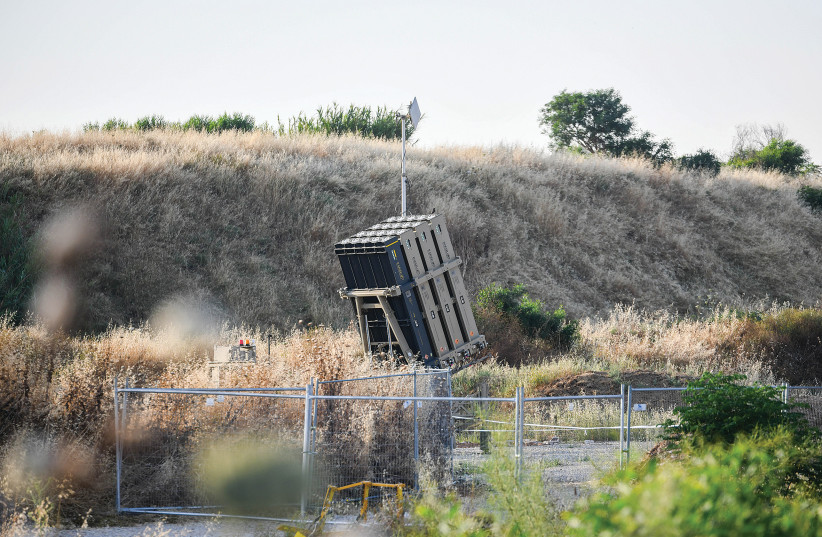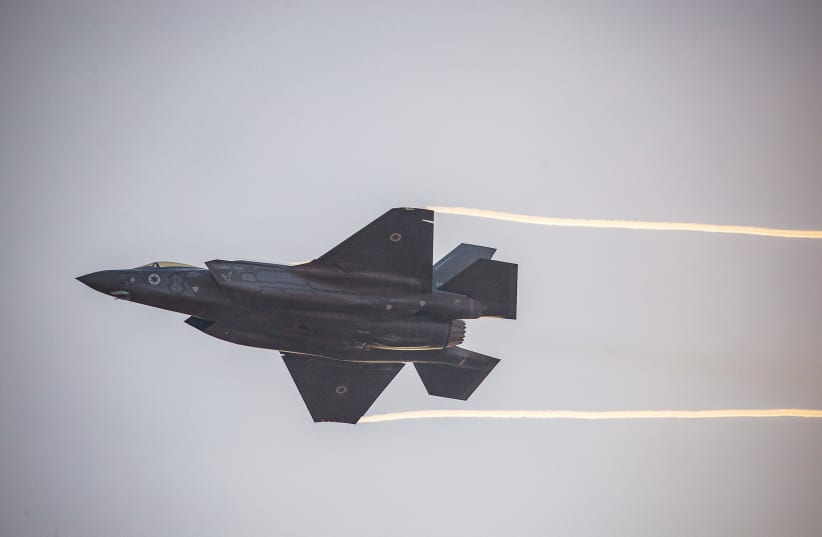The threat posed by Iranian drones in the crowded skies of the Middle East is a rising concern for Israel’s mighty air force, and one of the IAF’s top five threats.
This week the IAF revealed that two F-35I Adir aircraft had downed two Iranian drones that would have infiltrated Israeli airspace while on their way to deliver weapons to terrorist groups in the blockaded Gaza Strip.
The jets downed the drones far from Israel’s borders, to the east and to the south, almost simultaneously.
Though the IDF announced the feat this past week, it was the first time that F-35s had downed unmanned aerial systems anywhere in the world. The drones were downed in March 2021 by missiles fired by the stealth jets.
The timing of the announcement – late on Sunday night and as the world’s attention is on Ukraine, which is in the midst of the largest war in Europe so far in the 21st century – was unclear, but comes as Israel warns that Iran has been increasingly aggressive in the region.


Israeli officials estimate that Iran was attempting to test whether military equipment could be smuggled to Gaza via drone, and, if successful, whether more significant weapons could be smuggled in a similar way in the future.
Iran has been launching drones and other unmanned aerial systems toward Israel since 2018, and according to Tal Inbar, a senior research fellow at the US-based Missile Defense Advocacy Alliance, “every operational use of drones against our airspace is a test; it’s a continuous effort by Iran to be an influential power in the region.”
Following the attempted aerial infiltration of the unmanned aircraft systems, the IDF “studied and analyzed the attempts to launch the UASs and formulated an appropriate response,” said Maj.-Gen. Oded Basyuk, the head of the IDF’s Operations Directorate, adding that “we are required to continue learning, as long as the threat continues to exist.
“Time and time again, we have thwarted Iran’s attempts to carry out plans to launch the UASs toward Israel. At the same time, the IDF will continue to promote operational activities to prevent additional attempts,” Basyuk added.
For several years, Israel’s military has understood the threat posed by such systems, and the phenomenon has only increased with Iranian proxies such as Hezbollah in Lebanon and the Houthis in Yemen also using UASs to carry out attacks against countries in the region.
The IAF, which is considered the strongest air force in the Middle East, has admitted that identifying and intercepting hostile drones – be they drones belonging to Hezbollah in Lebanon, Hamas in Gaza or Iran – is challenging.
The drones are small, fly fast and low to the ground, making it hard for Israeli radar to detect them.
A week before the IAF announced the F-35 interceptions, Hezbollah flew a small remote-controlled aerial vehicle into northern Israel. According to the terrorist group, the platform was able to fly inside Israel for 40 minutes before being identified.
The IAF dispatched fighter jets to down it but decided that it would be too risky to intercept the device with a missile which, if it missed, could have fallen on residential areas such as Rosh Pina.
A Tamir interceptor missile was then launched from an Iron Dome battery, but it missed, and the Hezbollah platform was able to fly back to Lebanon into the hands of its operators.
It should have been intercepted, the IAF believes. The event should not have ended as it did.
Although the IDF has various ways to intercept drones, such as electronic warfare, the Iron Dome and fighter jets like the F-35, these small platforms are a challenge to identify and shoot down.
“You cannot have 100% hermetic defense against any threat,” Inbar said. “Even though the Iron Dome is effective against rockets, you can’t seal the skies hermetically, and from time to time we might see a penetration [by a UAS].”
Though the Iranian drones have yet to cause any damage or harm to Israel, the country is under a daily threat.
The March attempt by Iran to smuggle pistols to Palestinians using drones was not the first time that the Islamic Republic has tried to send weapons in this way.
In February 2018 Tehran attempted to send explosives to Palestinian terrorists in the West Bank using a Shahed 141 drone carrying TNT explosives.
The Iranian drone took off from the T4 airbase deep in the Syrian province of Homs and crossed into Israeli territory via Jordanian airspace. The drone was spotted by Israel and was intercepted near Beit She’an by an Apache attack helicopter.
There were also other attempted drone infiltrations after the two drones were taken out by the F-35s. In May 2021, during Operation Guardian of the Walls and three months after the two Shahed 197s were intercepted, Iran launched a drone from Iraq. It was downed by electronic warfare and fell into a fish pond in Kibbutz Maoz Haim, where it remained for over a month before the IDF was able to retrieve it.
IT’S A threat that is growing as time goes on.
Iran has been building its UAS fleet since 1984, and not only does it have a significant range of over 3,000 kilometers, but it has very advanced development and operational capabilities, making it a challenge for the IAF and the military’s aerial defenses to identify and intercept.
Iran has hundreds of drones and 48 different models, including those that are operational and others that are still in trial phases.
The two drones that were downed by the F-35Is were both Shahed 197s. The Shahed 197 was developed using reverse engineering from an American RQ-170 that fell inside Iran in 2011. It is powered by a micro turbojet engine and has an endurance of 20 hours and a combat range of 2,000 km.
The Islamic Republic has also designed UAVs able to operate in a swarm of over 10 drones.
A drone and missile swarm was first used by Iran in September 2019 against Saudi Arabia’s Aramco oil processing facility in Buqayq, some 1,000 kilometers from where the drones were launched. The attack disrupted the kingdom’s ability to produce oil for months and alerted the international community to the threat posed by Iran’s drone arsenal.
Iran has since carried out several more drone attacks, including the deadly attack on the ship Mercer Street that killed the British captain and Romanian security guard.
Tehran has also transferred UAS models and know-how to its proxies, such as the Houthis in Yemen, Hezbollah in Lebanon, and Hamas, and Palestinian Islamic Jihad in the Gaza Strip.
The IAF understands that the Islamic Republic’s defense industry is robust, constantly working to improve and manufacture systems and platforms that can threaten Israel and other countries in the region.
According to Inbar, “the threat is not new, and we know that Iranian drones are being supplied to Hezbollah in Lebanon, and we saw during Operation Guardian of the Walls in May several drones that were supplied by Iran being used by Palestinian Islamic Jihad. We’ve also seen the Houthis using drones to target Saudi Arabia and Abu Dhabi.”
IN NOVEMBER Defense Minister Benny Gantz said that the threat posed by the Islamic Republic is facing not only Israel but the entire world.
“One of the key tools is UAVs and precision weapons, which can reach strategic targets within thousands of kilometers, and thus this capability is already endangering Sunni countries, international troops in the Middle East and also countries in Europe and Africa,” the defense minister said.
A few months before that, in September, Gantz said that the Islamic Republic is training militias from Iraq, Yemen, Lebanon and Syria to operate and manufacture Iranian UAVs at its Kashan base north of the city of Isfahan.
“Iran has created ‘emissary terrorism’ under the auspices of organized terror armies that help it achieve its economic, political and military goals. Iran is trying to transfer its knowledge that will enable Iraq, Syria, and Lebanon – [and also those] in the Gaza Strip – to produce advanced UAVs,” he said at the time.
According to Gantz, terrorist operatives from those countries are being trained in flying Iranian UAVs at the base, “which is the cornerstone of Iranian aerial terrorism in the region.”
That aerial terrorism is a concern for the entire Middle East, and due to the increasing threat posed by UASs, and following the signing of the Abraham Accords, Israel has increased its presence in the Gulf States, including militarily.
On Wednesday IDF Chief of Staff Lt.-Gen. Aviv Kohavi landed in Bahrain to meet with senior officials, including Bahraini Defense Force Chief of Staff Lt.-Gen. Theyab bin Saqer Al Noaimi, Supreme Defense Council secretary-general Maj.-Gen. Nasser bin Hamad Al Khalifa, as well as the commander of the United States Naval Forces Central Command, US Fifth Fleet and Combined Maritime Forces, V.-Adm. Brad Cooper.
Though the IDF said that the visit is part of “ongoing cooperation” between the IDF and US Armed Forces, the meeting comes after reports that Israel is building a regional detection array at Hatzor Air Force Base with several countries in the area against drone attacks.
The Israeli radar system is expected to detect such threats for neighboring countries, as well as help destroy them.
According to Inbar, while the details of the visit will not be published, “every visit of a high-ranking officer to an Arab state is a statement. There are a lot of issues to be discussed – just remember the attacks on cargo ships in the Gulf.
“It’s a regional problem,” Inbar said. “The threat is not unique to Israel, and the decision to cooperate with regional countries is a matter of national politics and foreign relations.
“Of course, the Saudis have a lot to learn from our capabilities, and we can learn from their experience,” Inbar said, adding that while it’s a matter of foreign policy, “I hope to see future cooperation.”
